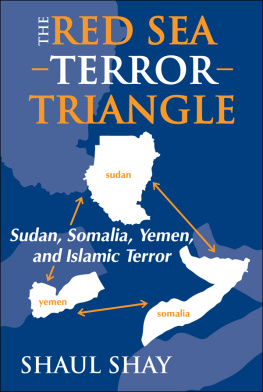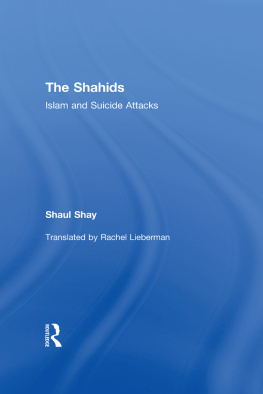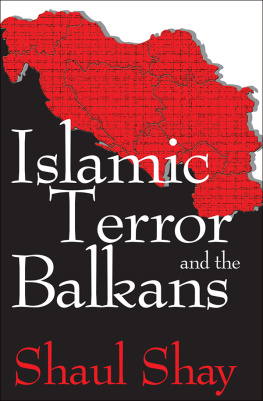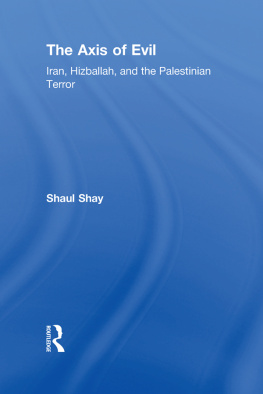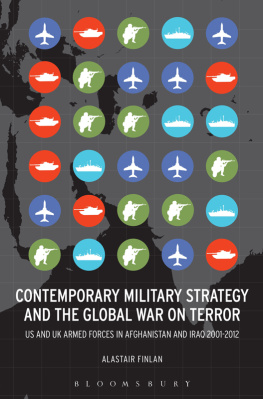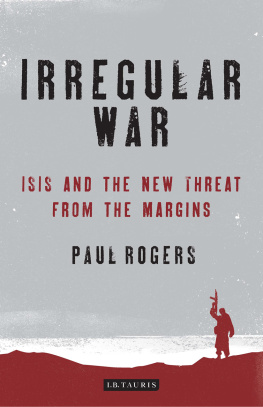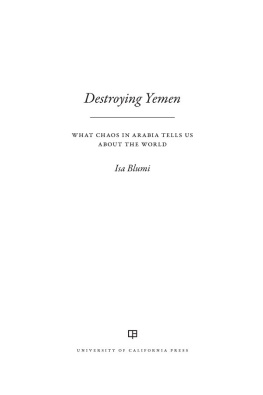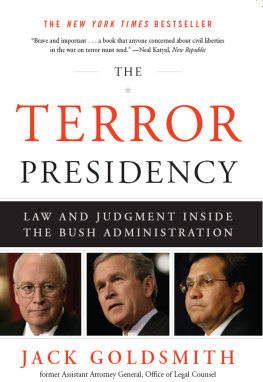First published 2005 by Transaction Publishers
Published 2017 by Routledge
2 Park Square, Milton Park, Abingdon, Oxon OX14 4RN
711 Third Avenue, New York, NY 10017, USA
Routledge is an imprint of the Taylor & Francis Group, an informa business
Copyright 2005 by The Interdisciplinary Center Herzliya Projects Ltd.
All rights reserved. No part of this book may be reprinted or reproduced or utilised in any form or by any electronic, mechanical, or other means, now known or hereafter invented, including photocopying and recording, or in any information storage or retrieval system, without permission in writing from the publishers.
Notice:
Product or corporate names may be trademarks or registered trademarks, and are used only for identification and explanation without intent to infringe.
Library of Congress Catalog Number: 2003055565
Library of Congress Cataloging-in-Publication Data
Shai, Shaul.
The Red Sea terror triangle : Sudan, Somalia, Yemen, and Islamic terror / Shaul Shay.
p. cm.
Includes bibliographical references and index.
ISBN 0-7658-0247-3 (cloth : alk. paper) ISBN 1-4128-0620-8 (pbk: alk. paper)
1. TerrorismSudanHistory. 2. TerrorismSomaliaHistory. 3. TerrorismYemenHistory. 4. Islam and terrorismSudan. 5. Islam and terrorismSomalia. 6. Islam and terrorismYemen. 7. SudanHistory. 8. SomaliaHistory. 9. YemenHistory. I. Title.
HV6433.S73S43 2004
303.6'25'0953dc22
2004051604
ISBN 13: 978-1-4128-0620-6 (pbk)
ISBN 13: 978-0-7658-0247-7 (hbk)
In the wake of the terror attacks on September 11, 2001, the United States declared war against global terror and set Al Qaida and the Taliban regime in Afghanistan as the initial targets of the campaign. A short time after the Coalition against Terror, with the US at its head, launched its offensive in Afghanistan, the question arose as to which country would serve as the next target in the counter-terror campaign. Politicians, security experts and academics indicated three countries that might be next in line in the war against terror; Sudan, Somalia and Yemen.
This assumption was not coincidental. It was based on the historical record of each of these countries, which was involved in some form or another in the provision of shelter and refuge to Islamic terror organizations, and in the case of Sudaneven in the direct support of these organizations and their operation.
The fear vis--vis the campaign waged by the United States and the Coalition against Terror prompted an about face in the Sudanese and Yemenite approaches, both of which hastened to denounce involvement in terror and aligned themselves alongside the United States in its war. In Somalia, which is defined as a failing state that lacks an effective central government, the various rival factions have declared that they support the war against terror, and cast accusations against each other regarding support and involvement in terror. The United States took vigorous steps to enlist these countries in the counter-terror campaign and demanded that the authorities take practical action against Islamic terror entities in their countries. Nevertheless, parallel to the growing cooperation, the United States and the coalition deployed air and sea forces in order to prevent the infiltration of Al Qaida activists and other radical Islamic terror organizations into countries in the region.
Sudan, Yemen and Somalia are located in a region of strategic importance, on both sides of the vital sea route linking the Arabian Sea (the Indian Ocean) and the Red Sea. All of the oil tankers from the Persian Gulf region pass through the Bab al-Mandab Straits, which are under the control of Eritrea and Yemen, on their way to Europe. The importance of the Horn of Africa and the Arabian Peninsula did not escape the attention of the colonial powers, which overtook this region and actively controlled it until the sixties of the twentieth century.
The three countries at the center of this study are Muslim states located at the periphery of the focal point of Islamic development and intensification (in the Arabian Peninsula, Egypt and the vicinity of the Fertile Crescent). These countries developed into national entities from within the reality of colonial government on the one hand, and the influence of the core Arab countries, on the other (for example, the Egyptian influence in Sudan or Saudi Arabian influence in Yemen).
Sudan and Somalia constitute an Islamic cultural bridgehead in the eastern and southern parts of the African continent. The geopolitical location of these countries attracted not only the colonial powers followed by the superpowers during the Cold War, but also radical Islamic entities that grasped the innate potential of this region vis--vis the fortification and dissemination of radical Islam. The involvement of Iran following the Khomeini Revolution and that of radical Islamic entities from Saudi Arabia left its stamp on the nations of that area and turned them into a focal point for confrontation with the West (mainly the United States). Osama Bin Laden, Al Qaida and members of radical Islamic organizations discovered allies and refuge in these countries. The presence of radical Islamic entities in the area, alongside local problems and conflicts on a national, ethnic and tribal basis, turned the countries in that region into a focal point for nations both near and far.
The aim of this book is to study the three countries which I have dubbed the terror triangle of the Red Sea, particularly the links that each of them maintains with Islamic terror and the reciprocal ties between them, based on the assumption that in the future all or some of them may constitute a basis for Islamic terror organizations.
The book contains five sections: The first three sections describe the historical, political and social developments in each of the countries and their involvement in Islamic terror. The fourth section describes the impact of Islamic terror that has developed in those three countries upon the entire region, as expressed in large terror attacks that were perpetrated in neighboring countries. The fifth section offers an integrative analysis of the characteristics of the three countries as well as the reasons for their involvement in terror. This section is also dedicated to an extensive discussion of cultural aspects that constitute the roots of Islamic terror, as well as the connection between Islamic terror and failing countries, which represent its preferred arena for activity. At the end of this section I will present an assessment regarding the characteristics of future terror threats, as well as recommendations regarding ways to contend with them in this arena.

